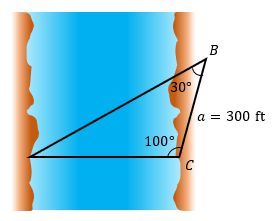Use the law of sines to find the indicated part of each triangle ABC.
Find A if B = 39° 50', b = 268 m, a = 340 m

459.6ft
195.8ft
152.3ft
233.4ft
 Verified step by step guidance
Verified step by step guidance
 4:27m
4:27mMaster Intro to Law of Sines with a bite sized video explanation from Patrick
Start learning